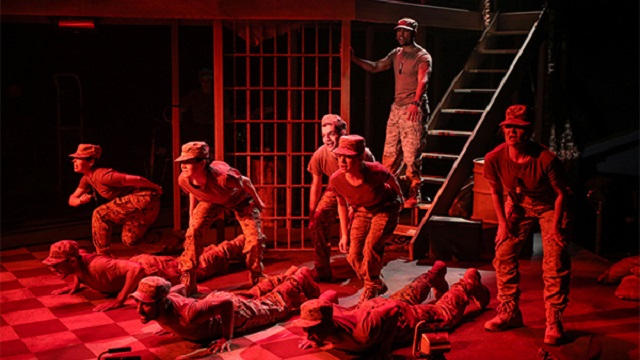This past weekend, Seattle’s ACT Theater just finished the second production of Bad Apples, a new musical about Abu Ghraib.
If you didn’t expect “musical” and “Abu Ghraib” to ever be in the same sentence, you’re not the only one. How could anybody make a musical about Abu Ghraib and keep it in good taste? In fact, the advertising imagery seemed to have bad taste pasted all over it. Circle X used the most famous image of the prisoner with a hood over his head standing on a box with electric wires attached to his body, and threw it in some sort of raver nightclub with laser lights and EL wire, promising a disco bloodbath of torture and irony in the worst possible way. Unfortunately, this was only short lived.

Now, let’s get something straight. Abu Ghraib is one of this nations most disgusting atrocities in the modern era. After being attacked with 9/11, America quickly ran over to Iraq on the false intelligence that terrorist cells had acquired weapons of mass destruction. Blinded by hurt and rage, we stormed over there with guns ablazing pretending to be the white knight saviors of an oppressed population. We were arresting anybody who we thought might have any little bit of information on terrorist cells and imprisoning them without trial, judge, or jury. While in prison, these people were dehumanized, humiliated, sexually violated, and tortured (sometimes to death) by both private contractors and Army prison guards.
Difficult to believe now, but reports of these atrocities started emerging in June 2003: 8 months after the passing of the Iraq resolution and after 3 months after the Iraq invasion actually began. Photographic evidence of the deviant behavior aired on 60 Minutes II in April 2004. Though there was evidence that the orders came from on high, only a handful of lower level guards were ever prosecuted for the abhorrent behavior. Donald Rumsfeld insisted that the behavior was the work of a group of a few “bad apples,” and not evidence of a wider pattern (though later reports proved that “enhanced interrogation techniques” were used in many locations, including Guantanamo and Afghanistan.
Which brings us to Bad Apples, a musical that has a lot on its mind about the nest of conditions that caused and allowed this behavior. Scripted by Jim Leonard (creator of Skin), Bad Apples focuses on an adaptation of a real life BDSM three-way relationship between one male guard and two female guards. By focusing on their soapily romantic relationship, Jim wants to humanize the three primary fall guys who captured the ire of the media. The argument that Bad Apples sets up is that these people aren’t necessarily GOOD people, but the government and media colluded to demonize the actual perpetrators and created a separation between the American public and these evil nasty people.
Chuck (Carlton Byrd), the male dominant based on Charles Graner, is a young black muscular sex god who has the ability to seduce any woman who comes in his path. And, we’re already the first and biggest of the problems. Graner was a racist white boy from the deep south. Charles Graner had a record of conducting racially-motivated abuse in his previous job as a prison guard, and had multiple restraining orders for abusing his ex-wife and family. At the time of the incidents, Graner was 36, much older than the other guards and had an air of authority. Changing this racist white man in average shape into an angry young muscular black sex god not only brings up extremely regressive stereotypes, it also eliminates much of the racial element within this lead guard. Extending past this, Leonard changes Graner’s history of domestic violence into a tale of racial bias where a black man married to a white woman is unfairly profiled and beat by the police in slow-motion. The racist heart at the center of Graner becomes a cycle of racism perpetrating itself on other races.
Lindsay Skinner (Kate Morgan Chadwick), based on Lynndie England, is one of the female submissives and submordinates involved in the three-way relationship. Here, she is a backwater redhead from a trailer park in the middle of Hicksville, USA. When she brings home Chuck on leave, her parents are shocked that she is hooking up with a black guy. She is totally fine with interracial dating, sending the message that she, and her real life counterpart, also weren’t necessarily racist pieces of shit. The two changes to these characters are meant to be easy ins into brief scenes of America’s own racism at home by showing us Skinner’s racist parents, and Chuck’s racist confrontation with the police. By making these changes, they inevitably introduce a whole litany of other problems, especially those of black men as oversexed ultra-violent out-of-control animals.
Lt. Scott (Keiko Green), the other submissive female, is Chuck’s superior and writes him up for perpetrating sexual infidelity with a married woman, Skinner. Well, she was about to except Chuck sexily convinces her to destroy the paperwork in exchange for a good roll in the hay. This power dynamic didn’t exist in real life. Real Life counter-part Megan Ambuhl actually ranked the same as Charles Graner, and was slightly lower in duties. Megan and Lynndie were subordinates to an older white man who exerted control over the proceedings. Lt. Scott, on the other hand, is a superior officer who goes weak in the knees at the sight of a sexy black guy.
Now, I’m not saying everybody involved in the scandal was white; men of color were prosecuted for their participation in the atrocities at hand. By changing the race of one of these three characters, Jim Leonard was aiming to take away the idea of white supremacy as an easy out, denying us an easy scapegoat on which to place the blame. While admirable in its intent, Leonard introduced other extremely problematic racial elements in its place. While there were many many other elements that didn’t work in this 3-hour musical (including 2 intermissions of <10 minutes), this was the one that left the worst taste.
Rounding out the main cast is Lt. Conny, a white evangelical who regularly confesses to his youth pastor back home. He is based on a real life white evangelical who regularly confessed to his youth pastor. True to life, Conny is the one who gave the incriminating photos to his pastor, who then turned it over to 60 Minutes II. The backup dancers in this production was a few Latino/Hispanic and white people to fill out the supporting characters: e.g. tortured prisoners, Dick Cheney, Donald Rumsfeld, white parents, private contractors, etc.
The racial elements that Leonard stirred up would have been troubling in service of a good musical, but Bad Apples is a very problematic musical that drunkenly lurches between sincerity and irony, trash and glam, soap opera artifice and neo-realism, restraint and wildly offensive bad taste. There’s no one tone, nor even one singular musical style, that connects the numbers over three hours. Musical styles range from acoustic guitar folk rock to techno to metal to white boys rapping badly. Much like the actual story, none of the styles seems to match anything else.
The first act is perhaps the most wildly ambitious, distasteful, ironic, disjointed act I have ever seen in my life. It introduces the scandal, sets up the relationship between Skinner and Chuck, brings in the racism of Skinner’s family, includes a torture musical number (including a guy getting stripped and hooded), and ends with the hijackers celebrating the night before 9/11 by going to Pizza Hut and fighting over the cost and whether or not to get pork on the pizza. The act finishes with the hijackers going to strip clubs set to a techno number titled “Last Night On Earth, Motherfucker.”
Luckily, the gleefully bad taste of that closer is matched by Act 2’s opening number: Donald Rumsfeld leads the audience in a bawdy bar-number sing-a-long that culminates with a water torture death. Sadly, these are the heights of blackly comic bad taste and ironic shock, leaving the rest of the musical to wallow in the dramatics of the threesome relationship and otherwise ignoring the atrocities that form the central narrative. Instead of getting this dysfunctional relationship amid tortured naked bodies, highlighting the contrast between human romance and soul-sucking inhumanity, Bad Apples merely wants to wallow around in the soap opera antics of our three anti-heroes. They get pregnant, engaged, jealous, and otherwise just generally roll around in their own desperate search for emotion.
Jim Leonard is trying to get the audience to understand that they could have done this under the same circumstances. He draws direct references to the Stanford Prison Experiment and The Lucifer Effect, directly tells us that the torture orders came from on high, and closes out the musical by turning the primary draw of the Army Reserve into an chipper ironic chorus, “Just One Weekend A Month.” Ironically, though not a showstopper – Bad Apples is woefully absent of actual show stoppers – this closer is the highest moment since the Act 2 opening bar song. It indicts the government for lying and suggests that anybody could have done these same acts.
Director John Langs created a boringly diverse stage on which he set all these proceedings. He knocked off several feet of the stage in order to put down 4 bar tables to seat audience members who were given a free pitcher of beer. This setting fits perfectly for the Act 1 closer/Act 2 opener in the bars, but is an otherwise useless touch unused by any other scene of the 3-hour 3-act musical. Instead, the set became narrower that added a welcome level of claustrophobia to the bigger dance numbers, and used an elevated balcony to create separation for foreground and background action…that is, again, only used during the slow-mo police beating musical number.
Oddly, despite all of the problems, the musical trucks along with a driving pace. Acts 2 and 3 were over before they began. Though I thought act 1 was the most entertaining act, it was also a trial as Bad Apples yanks the audience around like a rag doll. Sadly, this emotional whiplash all but dies to be replaced by a bullet-efficient musical of love, sex, and BDSM that all but ignores all of the atrocities happening around the relationship. This dichotomy asks the question: would I have preferred a 3-hour whiplash musical that mined a national horror for darkly humorous bad taste or an efficient musical that attempted to mine the psychology of the prison guards (even if it failed at both)? I think you all know the answer to that.

